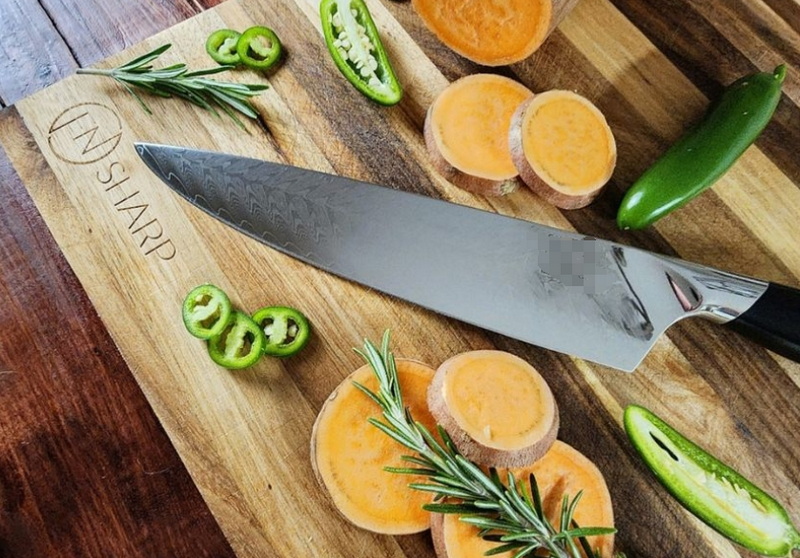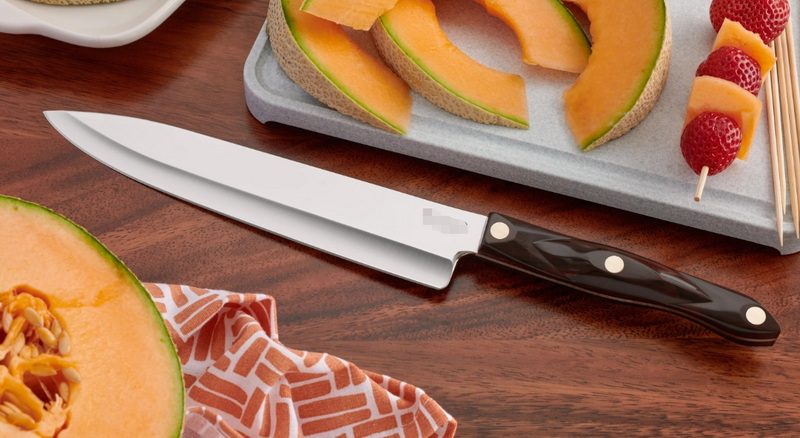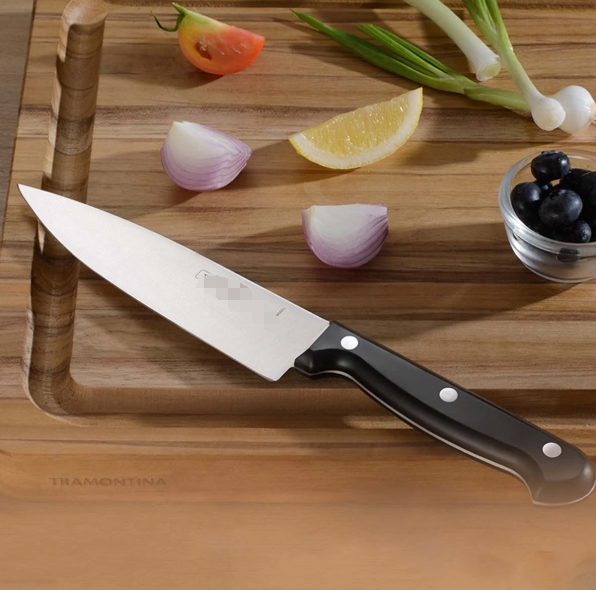

Views: 222 Author: Ella Publish Time: 2025-05-02 Origin: Site








Content Menu
● Why Does Chef Knife Size Matter?
● Common Chef Knife Sizes and Their Uses
● How to Choose the Right Chef Knife Size for You
>> 1. Consider Your Hand Size and Strength
>> 2. Assess Your Cooking Style
>> 3. Evaluate Your Kitchen Space
>> 4. Test the Knife's Balance and Grip
>> 5. Try Cutting Motions Before Buying
● Additional Factors to Consider When Choosing Chef Knife Size
>> Knife Maintenance and Sharpening
● Tips for Maintaining Comfort and Safety
>> 1. What is the most popular chef knife size?
>> 2. Can a bigger knife be better?
>> 3. How do I know if a knife is too big for me?
>> 4. Does knife size affect cutting technique?
>> 5. Should beginners start with a smaller or larger chef knife?
Choosing the right size for a chef knife is a crucial decision that can transform your cooking experience. The perfect chef knife feels like an extension of your hand, offering comfort, control, and efficiency in the kitchen. This comprehensive guide will walk you through everything you need to know about selecting the ideal chef knife size, from understanding different blade lengths to considering your hand size, cooking style, and kitchen space. Along the way, you will find helpful visuals and video recommendations to guide your choice.

The size of a chef knife affects how you handle it, the precision of your cuts, and your overall comfort during food preparation. A knife that is too large can feel cumbersome and unsafe, while one that is too small may limit your efficiency and control.
- Control and Precision: Smaller blades offer more control for detailed tasks like peeling or mincing herbs.
- Power and Efficiency: Larger blades excel at chopping big vegetables or breaking down meat.
- Comfort and Safety: The right size reduces hand fatigue and prevents accidents caused by awkward handling.
Understanding the importance of size helps you avoid common pitfalls such as hand strain, poor cutting technique, and even kitchen injuries. The right knife size empowers you to work confidently and swiftly, turning cooking from a chore into a creative and enjoyable activity.
Chef knives typically come in sizes ranging from 6 to 12 inches. Each size serves different purposes and suits different users.
The 6-inch chef knife is compact and nimble, making it ideal for cooks with smaller hands or those who prefer precision. Its shorter blade length allows for detailed tasks such as trimming pastry dough, chiffonading herbs, or peeling fruits. Because of its small size, it is easier to maneuver in tight kitchen spaces and is lighter, reducing hand fatigue during prolonged use.
However, the limited cutting surface means it may not be the best choice for chopping large vegetables or slicing big cuts of meat. It excels in tasks requiring finesse rather than brute force.
The 8-inch chef knife is the most popular and versatile size available. It strikes a balance between control and cutting surface, making it suitable for most kitchen tasks including slicing, dicing, and chopping. This size is often the go-to choice for professional chefs and home cooks alike because of its adaptability.
Its blade length provides enough surface area to efficiently handle medium to large ingredients, while still being manageable for users with average hand sizes. The 8-inch knife is often considered the “workhorse” in the kitchen.
The 10-inch chef knife is designed for handling large cuts of meat and big vegetables like pumpkins or watermelons. It provides more cutting power and efficiency for high-volume prep, making it a favorite in professional kitchens or for those who cook large meals regularly.
Because of its size and weight, it requires more skill and strength to control safely. It can be unwieldy for cooks with smaller hands or those not accustomed to handling larger blades.
The 12-inch chef knife is less common but useful for very large tasks or professional kitchens with heavy-duty needs. It offers the maximum cutting length, allowing for long, sweeping cuts and fast chopping of large quantities.
However, it can be cumbersome for many home cooks due to its size and weight. It demands excellent technique and strength to wield effectively and safely.

Choosing the right size chef knife depends on several personal factors. Here are the most important considerations to guide your decision:
Your hand size and grip strength play a significant role in determining the ideal knife size. If you have smaller hands, a 6-inch knife may feel more comfortable and easier to control. Larger hands or a stronger grip can handle 8-inch or 10-inch blades better.
A knife that fits well should feel like a natural extension of your arm, not a tool you struggle to manage. When holding the knife, your fingers should wrap comfortably around the handle without strain, and you should be able to maintain a secure grip even when your hands are wet.
Think about the types of food you prepare most often and the cutting techniques you use. If you frequently perform detailed work such as peeling, mincing, or slicing small fruits and vegetables, smaller knives offer the precision you need.
If your cooking involves chopping large vegetables, cutting meat, or preparing meals in large quantities, longer blades improve efficiency. For example, a 10-inch knife is great for breaking down whole chickens or slicing large melons, while an 8-inch knife covers a wide range of tasks effectively.
Your kitchen layout and available counter space also affect your choice. Larger knives require more clearance on your cutting board and countertop. If you have a compact kitchen or limited counter space, shorter blades are easier to manage and store.
Additionally, consider how you plan to store your knife. Larger knives may not fit in certain knife blocks or drawers, so ensure your storage solutions accommodate your choice.
Balance and grip comfort are essential for safe and efficient cutting. A well-balanced knife has its weight evenly distributed between the handle and the blade, making it easier to control.
When holding the knife, the handle should feel secure and comfortable in your hand. The blade should not feel too heavy or too light compared to the handle. Many knife manufacturers design their products with ergonomic handles to reduce hand fatigue.
If possible, mimic chopping or slicing motions with the knife before purchasing. The tip of the blade should clear the cutting board easily when rocking, and the length should feel natural for your wrist movement.
Many kitchen stores allow customers to handle knives, so take advantage of this opportunity to find a size that suits your style.
| Knife Size | Ideal For | Pros | Cons |
|---|---|---|---|
| 6-inch | Precision tasks, small hands | Lightweight, easy to control | Limited cutting surface |
| 8-inch | All-purpose, most cooks | Versatile, balanced, widely available | May feel large for very small hands |
| 10-inch | Large cuts, heavy-duty prep | Efficient for big tasks | Heavier, requires skill |
| 12-inch | Professional, large-scale prep | Maximum cutting length | Can be cumbersome for home use |
Besides length, the thickness and weight of the blade influence how the knife feels and performs. Thicker blades are sturdier and better for heavy-duty chopping, while thinner blades offer more precision and cleaner cuts.
Heavier knives can help with cutting through tough ingredients but may cause fatigue if used for extended periods. Lighter knives offer agility but may require more effort for dense foods.
The handle material affects grip comfort and safety. Common materials include wood, plastic, composite, and metal. Wood handles provide a traditional feel and good grip but require maintenance. Plastic and composite handles are durable and easy to clean.
The handle's shape and texture also matter. Ergonomic designs reduce strain and improve control. Some handles have finger grooves or textured surfaces to prevent slipping.
The size of the knife can influence how easy it is to sharpen and maintain. Larger knives may require special sharpening tools or more effort to keep sharp. Smaller knives are easier to handle during sharpening but may dull faster if used improperly.
Regular maintenance extends the life of your knife and ensures safety during use.
- Always choose a knife that fits your hand comfortably to avoid strain.
- Avoid knives that feel too heavy or too light; balance is key.
- Practice safe cutting techniques, especially with longer blades.
- Keep your knife sharp to reduce the effort needed for cutting.
- Use a proper cutting board to protect your knife and your hands.
- Store knives safely in a block or magnetic strip to prevent damage and accidents.
Choosing the right size for a chef knife is a personal decision influenced by your hand size, cooking habits, and kitchen environment. The 8-inch chef knife remains the most popular choice for its versatility and balance, but smaller 6-inch knives offer precision and maneuverability, while larger 10-inch knives provide power for heavy-duty tasks. Testing knives in person or mimicking cutting motions can help you find the perfect fit.
Ultimately, the best chef knife size is one that feels like a natural extension of your hand, enhancing your culinary skills and making food preparation a joy. Investing time in selecting the right knife size will pay off with improved comfort, safety, and cooking performance.

The 8-inch chef knife is the most popular and versatile size, favored by both professional chefs and home cooks for its balance of control and cutting surface.
Not always. Bigger knives offer more cutting power but can be harder to control and cause fatigue. The best size depends on your hand size and the tasks you perform.
If you struggle to maintain a secure grip, your wrist tires quickly, or the knife feels unwieldy during cutting motions, it may be too large. A proper fit should feel like an extension of your arm.
Yes. Shorter blades encourage more up-and-down chopping, while longer blades facilitate rocking motions and longer slicing strokes. Choose a size that complements your preferred technique.
Beginners often benefit from starting with an 8-inch knife, which balances versatility and manageability. Smaller 6-inch knives can also be good for those seeking more control.